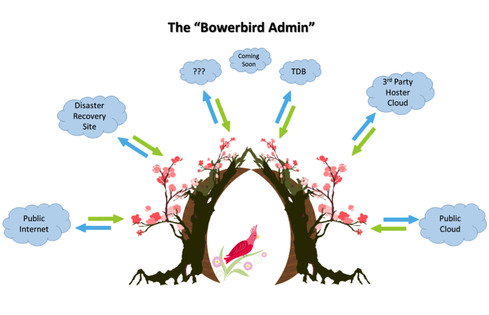Real-World SDN, Lesson 4: Plan For Hybrid Cloud
Microsoft's Symon Perriman explains why your software-defined network design should include support for hybrid cloud, whether you need it now or not.
October 9, 2014

You may not be using hybrid clouds now, but you should take them into account when designing your software-defined network (SDN). Even if your SDN is meant to achieve short-term goals, taking the time now to prepare for an industry-wide technology shift such as hybrid cloud computing could provide big benefits later on.
The National Institute of Standards and Technology (NIST) defines a hybrid cloud as "a composition of two or more distinct cloud infrastructures (private, community, or public) that remain unique entities, but are bound together by standardized or proprietary technology that enables data and application portability (e.g., cloud bursting for load balancing between clouds)." Today, many large enterprises already use public cloud services to support certain applications, but these tend to be isolated or cloud-specific platform services that lack access to on-premises resources.
This is creating challenges for IT departments that want an easy way to manage services, data, and users across multiple clouds. However, many problems could be resolved through a site-to-site hybrid cloud networking connection, providing cloud flexibility for enterprise applications.
Hybrid cloud networking refers to capabilities that seamlessly extend a company's on-premises network to another cloud, such as a public cloud or a third-party provider. This allows you to easily move virtual machines across clouds while maintaining IP addresses and other networking policies, just like a single extended network.
As an example, Microsoft's hybrid networking capabilities in Windows Server and Microsoft Azure include site-to-site VPN connections, private direct network connections through your ISP, and multitenancy for security and isolation, as well as automatic routing, multi-site topologies, integrated NAT to bypass site-to-site connections, and quality of service (QoS) features to control bandwidth use. This combination of features can provide hybrid cloud networking.
Although few cloud vendors offer hybrid services today, you should design your on-premises SDN solution to support public cloud connections in the future. In the animal world, there is a bird called the bowerbird that is known for planning ahead. The males spend countless hours building and decorating extremely intricate structures, or bowers (check out these examples).
The bowers are built so that the birds are prepared for when they meet their future mate, even though there is no immediate need for the structures -- nor any guarantee that a mate will even come along. But, like the bowerbird, you should build an SDN for the future by readying it for the hybrid cloud. As for attracting mates, I can't promise you anything!

As far as technology goes, there are clear benefits. Imagine if the front-end website of your distributed application could be hosted inside virtual machines on a public cloud -- taking advantage of its limitless and automated scaling capabilities -- while you only pay for resources you actually consume. Meanwhile, these VMs could transmit secured data through VPN networks to your back-end databases within your own datacenter, meeting your local compliance and privacy requirements.
Now imagine if this application could be continuously available by moving it between different public and private cloud datacenters in the event of a disaster, and if this entire solution could be managed by a single interface. I have good news for you: These hybrid cloud scenarios are a reality today with some cloud providers.
As you plan your SDN design, pay special attention to the self-service portal experience that you present to both admin and tenant users. These users could include administrators of the infrastructure or databases, user and identity managers, developers, or even regular employees that always want you to fix the Internet for them. Make sure that the self-service portal offers a consistent management experience to help reduce setup, operational, support, and training costs.
The portal should also offer hybrid cloud capabilities, or be able to support them in the future by providing an open and extensible platform. This will allow you to run services, virtual machines, or infrastructure across multiple clouds, which avoids vendor lock-in and can allow you to move your application based on business needs.
To summarize today's lesson, Symon says to be the "bowerbird admin" and design your SDN today to support the hybrid cloud of tomorrow, because this will best prepare your company to simultaneously take advantage of the private and the public cloud. Next, in the final post of this series, I'll discuss how you can influence the future of software-designed networking through engaging with your vendors.
About the Author
You May Also Like




